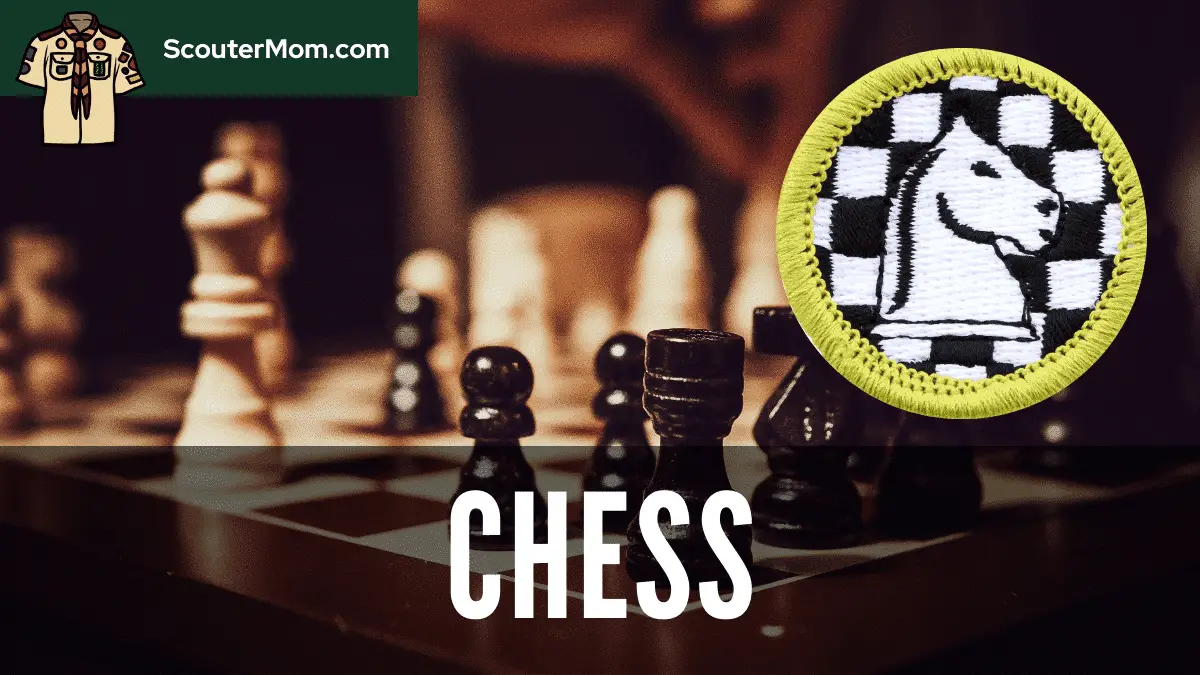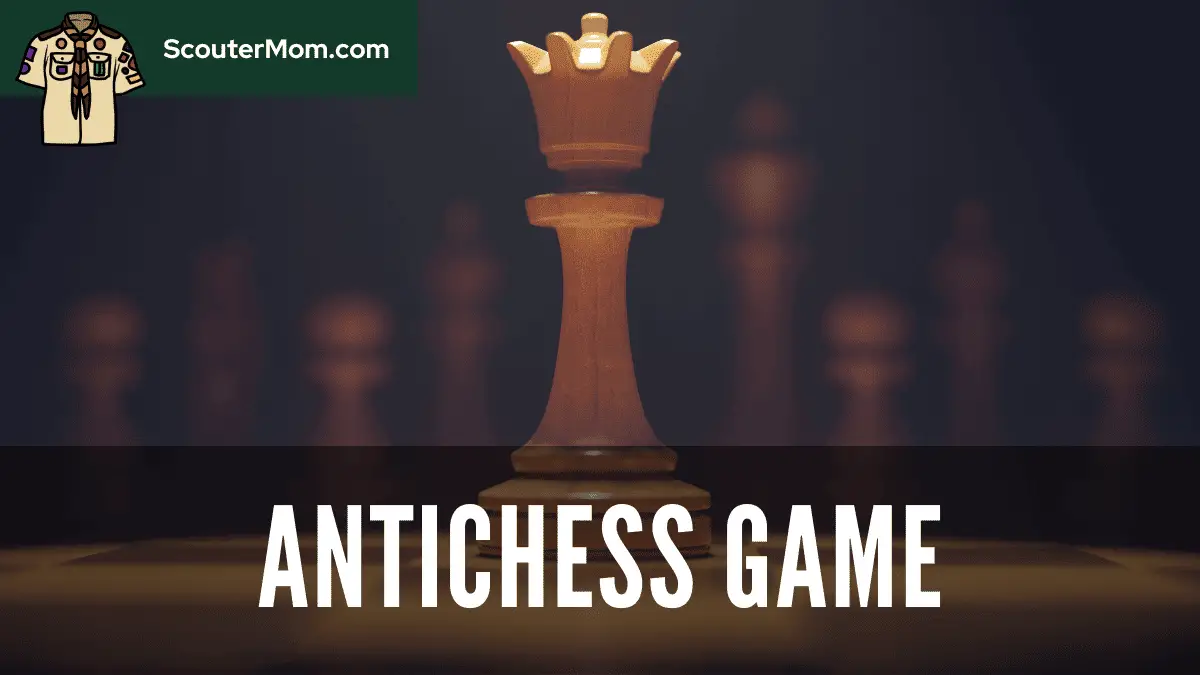
Scouts develop their critical thinking and strategy skills while doing the requirements for the Chess merit badge. They learn the history of chess, and chess notation. Scouts familiarize themselves with the tactics, board, pieces, and moves. Then they demonstrate their skills by playing some games of chess.
Chess is an elective merit badge.
Chess Merit Badge Resources
Chess Merit Badge Requirements
Answers and Helps
Requirement 1: The History of Chess
Requirement 2: Skills, Sportsmanship, and Etiquette
Requirement 3: Scouting’s Teaching EDGE
Requirement 4: Chess Knowledge
Requirement 5: Strategy and Tactics
Other Resources
Chess Merit Badge Requirements
See the current requirement from the Chess merit badge pamphlet below.
Chess Merit Badge Worksheet
Printable checkoff sheet for all Scouts BSA merit badges
Help with Answers for the Chess Merit Badge Requirements
Find specific helps for some of the Chess merit badge requirements listed below. Some of these resources will just give the answers. Others will provide engaging ways for older Scouts to introduce these concepts to new Scouts.
Ask Scouter Mom a question or share your ideas with others
Chess Merit Badge Requirement 1: The History of Chess
The History of Chess
The earliest form of chess was a game called chaturanga which was played in India in the 7th century or before. The version we play today developed around the 16th century. It became popular, and books about theory showed up in the mid 18th century. Read more.
Chess Merit Badge Requirement 2: Skills, Sportsmanship, and Etiquette
Chess Sportsmanship and Etiquette
- Be polite
- Don’t talk trash or intimidate
- Don’t argue
- Don’t give or ask for advice
- Don’t be annoying or distracting
- Stay near your game
- Don’t talk with those in the playing room
- Don’t try to trick your opponent by pretending to have made a bad move
- Be a good winner or loser
- Say “check” when appropriate
- Don’t be late to your game
- Read more
Chess Merit Badge Requirement 3: Scouting’s Teaching EDGE
Requirement 3 Helps and Answers

Scouting’s Teaching EDGE (BSA Edge Method)
This is a four step method for teaching a skill. It is sometimes called Scouting’s Teaching EDGE.
Chess Terminology
These are some very basic definitions to get you started.
Chess Terminology Scramble Puzzle
Use a word scramble puzzle to reinforce the meanings of some of those terms.
Chess Merit Badge Requirement 4: Chess Knowledge
Requirement 4 Helps and Answers
Opening / Middle Game / Endgame?
4 Basic Chess Opening Principles
Using Chess Notation
If you are not familiar with chess notation, this might seem a little daunting, but it really is pretty easy to learn.
Opening / Middle Game / Endgame?
The opening is the first 10 to 15 moves of the game. The middle game generally starts when pieces have been deployed and the kings have castled. When only a few pieces remain, you are in the endgame. Read more details.
4 Basic Chess Opening Principles
- Central control
- Progressive development
- King safety
- Piece activity
4 Rules for Castling
- The king and the rook may not have moved from their starting squares if you want to castle.
- All spaces between the king and the rook must be empty.
- The king cannot be in check.
- The squares that the king passes over must not be under attack, nor the square where it lands on.
How to Draw a Game
- stalemate
- threefold repetition
- agreement
- insufficient material
- perpetual check
- the 50 move rule
Chess Merit Badge Requirement 5: Strategy and Tactics
Requirement 5 Helps and Answers
Exploiting Weaknesses
A weakness is simply a flaw in a position that we can exploit. These weaknesses can be anything from an open line to poor piece placement to overworked pieces. Depending on what stage we are at in the game we will see different weaknesses in our opponent.
Forcing Moves
A forcing move is one which requires the opponent to reply in a certain way, or which greatly limits the ways in which he can respond. Essentially, a forcing move is either a check, a capture, or a threat.
King Safety
Pawn Structure
In chess, the pawn structure (sometimes known as the pawn skeleton) is the configuration of pawns on the chessboard. Because pawns are the least mobile of the chess pieces, the pawn structure is relatively static and thus largely determines the strategic aspect of the position.
Space and Attack
Space is “control of squares”. So a player with a “space advantage” is one who controls a greater number of squares. If one side controls more of the board, the other side’s pieces are cramped and trip over each other.
Tempo
Time
The time is for each move. It can be anywhere from a few minutes to a day or more. So 1 day to move would mean you have 24 hours to make your move, and after your opponent replies, you have another 24 hours to make your next move, etc.
Interposing
Interposing is a way to block a check. An interposing move would be one in which a player moves a piece between their king and the opponent’s piece which has placed the king in check.
Overprotecting
Overprotection refers to a strategically important pawn or square that is given more protection than it seemingly needs. Essentially a prophylactic maneuver, the side that overprotects does so in order to dissuade the opponent from launching an attack against that point.
Chess Merit Badge Requirement 6: Playing Chess
Requirement 6 Helps and Answers
How to Organize a Chess Tournament
- Select a date and site
- Determine the format
- Form a committee to help
- Work with the site facilities
- Purchase awards
- Arrange for concessions
- Run the tournament
- Read more details
Other Resources

Antichess Game
Do you feel like you always lose when you play chess? If you are better at getting your own pieces captured than capturing your opponents pieces, then Antichess is the game for you. In Antichess (sometimes called Suicide Chess or Giveaway Chess) the object is to lose all of your pieces.
Bughouse Chess Game
Bughouse (or Bunk House) is a game which helps even the playing field. Basically, there are two teams which simultaneously play chess together. Each player has a direct opponent, but when he captures a piece, he passes it to one of his teammates to play on the board. The key is to have the direct opponents as evenly matched as possible and then to have the teams fairly well balanced in skill level.
Atomic Chess Game
Do you think regular chess is boring? Then try atomic chess. In atomic chess, pieces don’t just capture other pieces, they explode! Both pieces involved in the capture are destroyed along with any in the surrounding area. Sound like fun?

